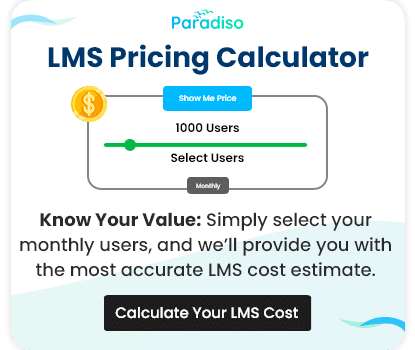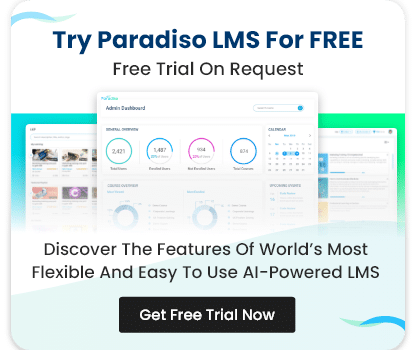The eLearning industry has experienced consistent growth, with organizations worldwide recognizing the importance of learning and development as a core function to foster their growth initiatives. This shift in perspective has been met with enthusiasm by their employees, who see the value in continuous learning and skill development.

Types of eLearning Content: Off-the-Shelf vs. DIY vs. Custom
However, once organizations acknowledge the significance of learning and development, they often encounter a significant challenge: creating effective eLearning content. In today’s fiercely competitive landscape, a robust L&D strategy supported by high-quality content is essential for not only survival but also thriving. In this blog, we will explore various approaches to building eLearning content and determine which one is the optimal choice for your company. Before delving into these approaches, it’s crucial to highlight some essential considerations.
Off the shelf content
Off-the-shelf eLearning content refers to pre-made courses and materials readily available from third-party providers. These resources cover a wide range of topics and are designed to be easily accessible and deployable by organizations seeking quick solutions to their training needs.
Pros of Off-the-Shelf Content:
- Time and Cost Efficiency: Off-the-shelf eLearning content saves time and money by eliminating the need to create content from scratch. It’s readily available, reducing development time.
- Variety and Depth: A wide array of topics and courses are available, covering diverse subject matter and catering to different learning needs.
- Expertise: Content is often created by subject-matter experts, ensuring accuracy and relevance.
- Accessibility: It’s accessible to organizations of all sizes, making quality training resources available even to smaller companies.
Cons of Off-the-Shelf Content
- Lack of Customization: Off-the-shelf training content may not align perfectly with an organization’s specific needs, requiring additional customization.
- Limited Flexibility: Customization options are limited, restricting the ability to tailor content to unique learning objectives.
- Generic Approach: It may not fully capture the organization’s culture, values, or industry-specific nuances.
- Competitive Disadvantage: Since multiple organizations may use the same content, it can dilute a company’s competitive edge and differentiation in training.
DIY Content:
DIY eLearning content is created in-house by an organization’s own instructional designers, subject-matter experts, or trainers. This approach involves developing customized learning materials tailored to the organization’s specific needs and objectives.
Pros of DIY Content:
- Customization: DIY content allows for complete customization, ensuring that training materials align precisely with an organization’s unique requirements and goals.
- Flexibility: Organizations have full control over content development, making it easy to adapt to changing training needs or industry-specific updates.
- Cost Efficiency in the Long Run: While initial development may require more resources, in the long term, DIY content can be more cost-effective as it eliminates ongoing licensing fees for third-party content.
- Enhanced Engagement: Customized content often resonates better with employees, increasing engagement and retention.
Cons of DIY Content:
- Resource-Intensive: Creating DIY content demands significant time, effort, and expertise, which may strain an organization’s resources.
- Skill Requirements: Developing effective eLearning content requires a skilled team proficient in instructional design, multimedia development, and content creation.
- Time-Consuming: DIY content development can be time-consuming, potentially delaying training implementation.
- Quality Assurance: Without proper quality control measures, DIY content may lack the same level of professionalism as professionally developed materials, affecting the overall learning experience.
Custom eLearning Content
Custom eLearning content is tailor-made, designed, and developed to precisely fit the unique needs and objectives of an organization. It is created from scratch or heavily modified to align with an organization’s branding, culture, industry, and specific learning outcomes.
Pros of Custom eLearning Content
- Perfect Alignment: Custom content is a precise match for an organization’s requirements, ensuring that the training directly addresses specific learning objectives.
- Enhanced Engagement: Customization allows for the integration of interactive elements, gamification, and multimedia, leading to higher learner engagement and improved knowledge retention.
- Brand Consistency: Custom content reflects an organization’s brand identity, values, and culture, reinforcing brand consistency across all training materials.
- Competitive Edge: Custom content sets an organization apart, providing a unique and differentiated training experience that can be a competitive advantage.
Cons of Custom eLearning Content
- Cost-Intensive: Custom content development can be expensive due to the extensive time and expertise required, often surpassing the budget of smaller organizations.
- Resource-Heavy: Creating custom content demands a dedicated team with expertise in instructional design, multimedia development, and project management, which may not be readily available.
- Development Time: The time required to create custom content can delay training implementation, especially for time-sensitive needs.
- Maintenance Challenges: Regular updates and maintenance can be complex and resource-intensive, especially as content complexity increases.
Which option should you choose?
The choice between off-the-shelf, DIY, or custom eLearning content ultimately depends on several factors unique to your organization, such as your specific training goals, budget, resources, and timeline. Here’s a brief guide to help you decide:
Off-the-Shelf Content:
- Choose this option if you need cost-effective and readily available training materials.
- Ideal for standardized topics with minimal customization needs.
- Suitable for smaller organizations with limited resources.
DIY (Do-It-Yourself) Content:
- Opt for DIY if you require highly customized content that aligns precisely with your unique learning objectives.
- Suitable if you have the expertise and resources to develop and maintain content in-house.
- Allows for flexibility in content development and updates.
Custom eLearning Content:
- Consider custom content if you want a training experience that reflects your organization’s brand, culture, and industry nuances.
- Ideal for complex or specialized training needs.
- Suitable for organizations with the budget and resources to invest in tailored solutions.
Conclusion
In many cases, a blended approach may be the best solution, combining off-the-shelf content for general topics, DIY content for moderately customized needs, and custom content for highly specialized or critical training areas. Evaluating your specific requirements, resources, and long-term training objectives will help you make the most informed choice for your organization’s eLearning content strategy.










